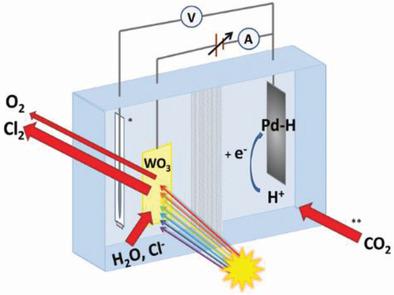当前位置:
X-MOL 学术
›
Adv. Energy Mater.
›
论文详情
Our official English website, www.x-mol.net, welcomes your
feedback! (Note: you will need to create a separate account there.)
Highly Efficient Sunlight‐Driven Seawater Splitting in a Photoelectrochemical Cell with Chlorine Evolved at Nanostructured WO3 Photoanode and Hydrogen Stored as Hydride within Metallic Cathode
Advanced Energy Materials ( IF 24.4 ) Pub Date : 2019-12-09 , DOI: 10.1002/aenm.201903213 Michal Jadwiszczak 1 , Katarzyna Jakubow‐Piotrowska 1 , Piotr Kedzierzawski 2 , Krzysztof Bienkowski 1 , Jan Augustynski 1
Advanced Energy Materials ( IF 24.4 ) Pub Date : 2019-12-09 , DOI: 10.1002/aenm.201903213 Michal Jadwiszczak 1 , Katarzyna Jakubow‐Piotrowska 1 , Piotr Kedzierzawski 2 , Krzysztof Bienkowski 1 , Jan Augustynski 1
Affiliation

|
A seawater splitting photoelectrochemical cell featuring a nanostructured tungsten trioxide photoanode that exhibits very high and stable photocurrents producing chlorine with average 70% Faradaic efficiency is described. Fabrication of the WO3 electrodes on fluorine‐doped tin oxide substrates involves a simple solution‐based method and sequential layer‐by‐layer deposition with a progressively adjusted amount of structure‐directing agent in the precursor and a two‐step annealing. Such a procedure allows tailoring of thick, highly porous, structurally stable WO3 films with a large internal photoactive surface area optimizing utilization of visible light wavelengths by the photoanode. With the application of an anodic potential of 0.76 V versus Ag/AgCl reference electrode (0.4 V below the thermodynamic Cl2/Cl− potential) in synthetic seawater, the designed WO3 photoanodes irradiated with simulated 1 sun AM 1.5G light reach currents exceeding 4.5 mA cm−2. Photocurrents close to 5 mA cm−2 are attained in the case of fresh water splitting using 1 m methane–sulfonic acid supporting electrolyte with oxygen evolved at the WO3 photoanode. The amount of formed hydrogen is determined by discharging the palladium sheet electrode employed as a cathode. Collection of hydrogen in the form of a hydride opens, more generally, the prospect of subsequently using such materials as anodes in batteries employing oxygen reduction cathodes.
中文翻译:

光电化学电池中的高效阳光驱动海水裂解,其中氯在纳米结构的WO3光电阳极中逸出,氢作为氢化物存储在金属阴极中
描述了一种海水分裂光电化学电池,其特征在于纳米结构的三氧化钨光阳极表现出非常高和稳定的光电流,产生的氯平均法拉第效率为70%。在掺氟的氧化锡衬底上制造WO 3电极涉及一种简单的基于溶液的方法以及连续的逐层沉积,逐步调整前体中的结构导向剂的量并进行两步退火。这样的程序允许定制厚的,高度多孔的,结构稳定的WO 3。具有较大内部光敏表面积的薄膜可优化光电阳极对可见光波长的利用。与为0.76V相对于Ag / AgCl参比电极(热力学氯低于0.4 V的阳极电势的施加2 /氯-电位)在合成海水中,设计WO 3个光阳极与模拟1个太阳AM 1.5G光到达电流超过照射4.5 mA cm -2。在使用1 m甲烷-磺酸支持电解质并在WO 3处放出氧气的情况下进行淡水分解的情况下,可获得接近5 mA cm -2的光电流。光电阳极。通过放电用作阴极的钯片电极来确定氢的形成量。更普遍地,以氢化物形式的氢的收集打开了随后在使用氧还原阴极的电池中使用这种材料作为阳极的前景。
更新日期:2020-01-22
中文翻译:

光电化学电池中的高效阳光驱动海水裂解,其中氯在纳米结构的WO3光电阳极中逸出,氢作为氢化物存储在金属阴极中
描述了一种海水分裂光电化学电池,其特征在于纳米结构的三氧化钨光阳极表现出非常高和稳定的光电流,产生的氯平均法拉第效率为70%。在掺氟的氧化锡衬底上制造WO 3电极涉及一种简单的基于溶液的方法以及连续的逐层沉积,逐步调整前体中的结构导向剂的量并进行两步退火。这样的程序允许定制厚的,高度多孔的,结构稳定的WO 3。具有较大内部光敏表面积的薄膜可优化光电阳极对可见光波长的利用。与为0.76V相对于Ag / AgCl参比电极(热力学氯低于0.4 V的阳极电势的施加2 /氯-电位)在合成海水中,设计WO 3个光阳极与模拟1个太阳AM 1.5G光到达电流超过照射4.5 mA cm -2。在使用1 m甲烷-磺酸支持电解质并在WO 3处放出氧气的情况下进行淡水分解的情况下,可获得接近5 mA cm -2的光电流。光电阳极。通过放电用作阴极的钯片电极来确定氢的形成量。更普遍地,以氢化物形式的氢的收集打开了随后在使用氧还原阴极的电池中使用这种材料作为阳极的前景。









































 京公网安备 11010802027423号
京公网安备 11010802027423号